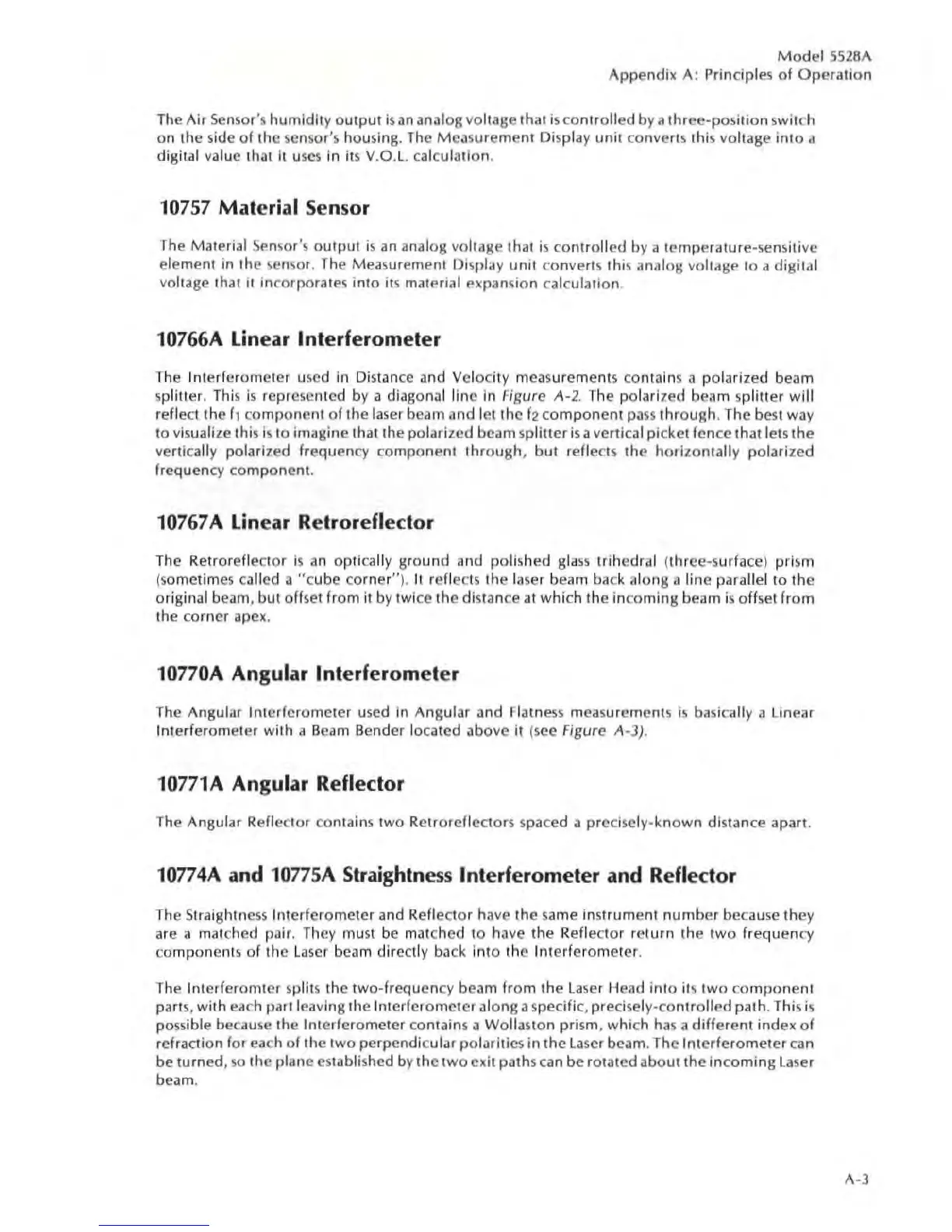Model
5528A
Appendix
A: Principles
of
Operation
The
Air
Sensor's
humidity
output
is
an
analog
vo
ltage that
is
controlled
by a
three
-
position
switch
on
the side
of
the sensor's housing. The Measurement
Di
splay unit c
onvert
s this voltage
into
a
digital value thilt it us
es
in its V.
O.l.
calculation.
10757
Material
Sensor
The Material Sens
or
's
output
is
an
analog voltage that
is
c
ontrolled
by a temperature-sensitive
element in
Ihe sensor. The Meas
ur
ement
Di
splay
unit
converts this amllog voltage to a
diMi
t
al
voltage that iI
in
corporates
into
its
maTer
i
al
expans
ion
calcula
tion
.
10766A Linear
Interferometer
The Interferometer used
In
Distance and Velocity measurements contains a polarized beam
sp
litter. This
is
represented by a diagonal
line
in Figure
A-2
. The polarized beam
sp
li
tter
wilt
reflect the ft component
of
the laser beam and let the f2
component
pas
s
through
. The best way
to
vi
sualize this is to imagine that the polarized beam s
plitter
is
a vertical
picket
fence that lets
the
vertically polarized frequency component through,
but
reflec
ts
the
hori
z
ontally
polarized
frequency
component
.
10767
A Linear
Relroreflector
The Retroreflec
tor
is
an
optically
ground
and polished
glass
trihedral (
thrce
-s
urface)
pri
sm
(somctimcs
ca
lled a " cube corner"
).
It
reflec
ts
the
la
ser beam back along a
lin
e parallel to the
original
beam,
but
off
s
et
from
it by twice
thc
di
stance
at
which the
incoming
beam
is
offset
from
the
corner
apex.
10770A
Angular
Interferometer
The Angular
Int
erferometer
used
in Angular and Flatne
ss
measurements
is
basically a
linear
Inte
rf
erometer with a
Ream
Bender located above it (sec Figure A-J).
10771A
Angular
Reflector
The Angular Reflec
tor
contains two Retroreflectors s
pa
ced a precisely-kno
wn
di
stance apart.
10774A
and
10775A
Straightness
Interferometer
and Reflector
The Straightn
ess
Interferometer and Reflector have the same instrument
number
because they
are
a matched pair. They must be matchcd
to
have
the
Reflector return the
two
frequency
components of
the
Laser
beam directly back
into
the I
nterferometer
.
The
Interferomter
splits the
two
-frequency beam
from
the
La
s
er
Head
into
its
two
c
ornponent
parts, with eilch part leaving the
Interferometer
along a specific, precis
ely-controlled
pa
th. This
is
possible bec
au
se the Interferometer contains a Wollas
ton
prism. which
ha
s a
diffe
r
ent
index
of
refraction for
ea
ch
of
the
two
perpendicular
po
larilies
in
the
la
ser beam. The
Int
erferometer
can
be
turned
, so the plane established by the
two
exit
path
s can be rotated
about
the
in
c
oming
laser
beam.
A·3

